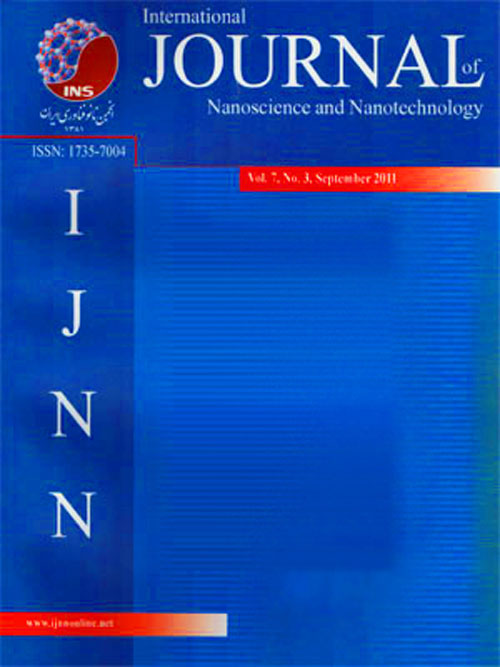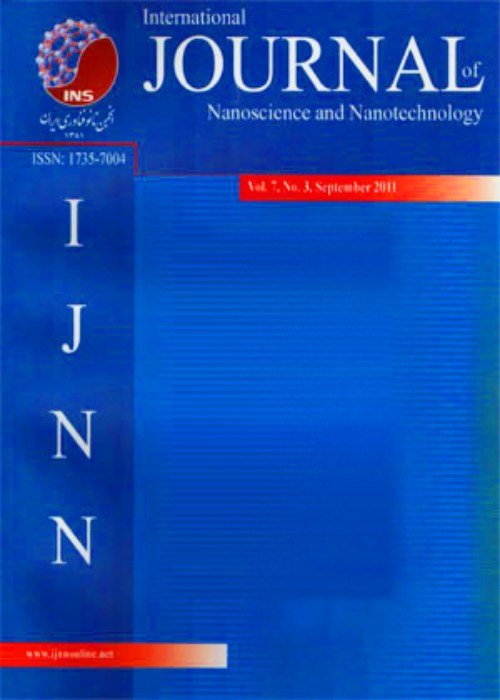فهرست مطالب

International Journal Of Nanoscience and Nanotechnology
Volume:11 Issue: 2, Spring 2015
- تاریخ انتشار: 1394/03/29
- تعداد عناوین: 8
-
-
Pages 63-70In this research, CuO spherical-like nanoparticles were synthesized using the planetary ball mill method. The structure, particle size and morphology of the resulting CuO nanoparticles were characterized by XRD (X-ray diffraction), SEM (scanning electron microscopy) and SAXS (small-angle X-ray scattering) methods. The results of this investigation showed that the smallest particles which were only 82nm in size were achieved by ball milling at dry medium during 20h. These nanoparticles were studied as an additive for promoting the thermal decomposition of ammonium perchlorate (AP). For the first time, CuO nanoparticles were synthesized by planetary ball mill method for the thermal decomposition of AP. DSC (differential scanning calorimetry) and TGA (thermo gravimetric analysis) techniques were applied to investigate the thermal decomposition of pure AP with and without CuO nanoparticles. Addition of 2%CuO nanopowder with 82 nm particle size to AP increased heat decomposition from 880 to 1719.87J/g. Also, addition of 2%CuO nanopowder with 82nm particle size to AP decreased the thermal decomposition temperature from 421.99 to 351.77°C.Keywords: CuO nanoparticles, Ball Mill, AP, Catalytic Activity, Thermal Decomposition
-
Pages 71-82In this study, a model for estimating the NFs thermal conductivity by using a GMDH-PNN has been investigated. NFs thermal conductivity was modeled as a function of the nanoparticle size, temperature, nanoparticle volume fraction and the thermal conductivity of the base fluid and nanoparticles. For this purpose, the developed network contains 8 layers with 2 inputs in each layer and also training algorithms of least squares regression. The obtained results of the model have shown good accuracy of hybrid GMDH-PNN for estimating the thermal conductivity of NFs. The RMSE of the model for 24 systems containing 211data sets was achieved 0.0224. MAPE for training and validation data setswere3.58 and 3.2%, respectively. Also, the proposed hybrid GMDH-PNN model was compared with different models from the literature. The results showed that the developed model can successively correlate and predict the thermal conductivity of different groups of NFs. Moreover, a remarkable agreement for the model with the experimental data was achieved with respect to the other models from the literature.Keywords: Artificial neural network, GMDH, PNN model, Nanofluids, Thermal conductivity
-
Pages 83-92The effect of geometry and material of the Micro/Nano particle on contact mechanic for manipulation was studied in this work based on atomic force microscopy. Hertz contact model simulation for EpH biological micro particle with spherical, cylindrical, and circular crowned roller shape was used to investigate the effect of geometry on contact simulation process in manipulation. Then, to validate the simulation results, they were compared to experimental ones. The results can be interpreted from two perspectives, first from the perspective of types of nanoparticles and second from the perspective of types of theories.To investigate the effect of the material of micro/nano particle in contact mechanic simulation process, spherical contact simulations of two EpH and C3T3 cells were compared with each other. EpH cells simulations with different geometries showed that the cylindrical shape estimation did not provide accurate response due to longer contact length. However, spherical and circular crowned roller estimations which had 19.6% and 15.6% difference from experimental results, respectively, had relatively accurate response. Therefore, selection of circular crowned roller geometry will produce more logical response. Also, the comparison of spherical contact simulation of EpH and C3T3 cells showed that C3T3 cell shows more indention depth under the same applied force.Keywords: Contact Mechanic, Geometry, Hertz contact model, Micro, nano manipulatn
-
Pages 93-99Functionalization of multiwalled carbon nanotubes (MWCNTs) with NH2 groups under a one pot reaction is studied. During the first step of the reaction, Cl and CHCl2 groups were attached to the surfaces of MWCNTs through an electrophilic addition reaction. In the second step of process, Cl atoms were replaced with NH2 and amino groups (ethylene diamine and butyl amine) under a nucleophilic substitution reaction. The aminated MWCNTs have high solubility and dispersion stability in organic solvents and polymeric matrixes. FTIR, XRD, TGA and Raman spectroscopy were used for characterization of the achieved products. The analysis results indicate that the MWCNTs functionalized with high concentration of amino groups. Also, treated CNTs show good dispersity and interfacial compatibility when used to make MWCNT/polymer composites. Proposed method is an efficient route to introduce of amino groups onto the surfaces of MWCNTs and the process is a very effective, clean, safe and easy to operate, and the scale up of this method is easy.Keywords: Amination, Functionalization, Multiwalled carbon nanotubes, One Pot, Solubilization
-
Pages 101-113Europium (Eu) doped ZnO microsphere based nano-sheets were synthesized through hydrothermal method. Effects of different concentrations of Europium on structural and optical properties of ZnO nano-sheets were investigated in detail. Prepared un-doped and Eu-doped ZnO samples were characterized using X-Ray diffraction (XRD), energy dispersive X-ray spectroscopy (EDX), scanning electron microscopy (SEM), diffuse reflectance spectroscopy (DRS) and Photoluminescence (PL) spectroscopy at fluorescence and phosphorescence modes. Results for XRD and EDX showed Eu ions were successfully incorporated into ZnO nanostructures. Fluorescence Spectroscopy indicated that indirect excitation of Eu ions was more effective than direct excitation, which is attributed to an efficient absorption process at UV wavelengths in ZnO host and energy transfer from photon generated electron-hole pair in the ZnO nano-sheets to Eu ions at indirect excitations. Phosphorescence spectroscopy also showed a sharp red luminescence from intra 4f transitions of Eu3+ ions at excitation wavelengths of 395nm and 464nm which was consistent with XRD and EDX resultsKeywords: Hydrothermal, Photoluminescence, Nano, sheets, ZnO
-
Pages 115-122Nano-sized titanium dioxide TiO2 powder was prepared by new wet chemical route from its precursor Titanium (IV) chloride (TiCl4) as precursor with isopropoxy alcohol in presence of nitric acid under ambient condition. Their morphologies, phase compositions and components of the TiO2 nanoparticles were characterized by transmission electron microscopy (TEM), field emission scanning electron microscopy (FE-SEM), X-ray diffraction (XRD), electron dispersive spectroscopy (EDS), Fourier transform infrared spectroscopy (FTIR) and UV-Vis spectrophotometer. The TEM results showed the as-synthesized TiO2 formed in nanometer scale. The FE-SEM images showed that the size of TiO2 nanoparicles decreased with increasing annealing temperature while the uniformity of size distribution decreased. The FE-SEM images also revealed that the size of annealed TiO2 nanocrystals increased with increasing the value of nitric acid. The average grain size of anatase nanoparticles was obtained about 25nm. The crystal structure of the nanoparticles before and after annealing was analyzed by XRD analysis. When the calcinations increased above 550oC, the phase transformation of anatase to rutile occurred, but the anatase phase was still dominant. The sharp peaks in FTIR spectrum determined the purity of TiO2 nanoparticles and absorbance peak of UV-Vis spectrum showed anatase phase at wavelength about 380 nm with band gap of 3.26 ev for as-prepared TiO2 and rutile phase at wavelength about 382 nm with band gap of 3.24 ev for annealed TiO2 nanoparticles. The EDS spectrum showed peaks of titanium and oxygen.Keywords: Nano, TiO2, Wet chemical, Synthesis, Phase transition, Anatase phase
-
Pages 123-131ZnO nanostructures have been synthesized by a simple reflux method, using different ionic liquids, such as 1-benzyl-3-methylimidazolium bromide ([BzMIM][Br]), 1,1''-(1,4 phenylenebis (methylene)) bis (3-methyl-1H-imidazol-3-ium) bromide ([MM-1,4-DBzIM2][Br]2) and 1-phenacyl-3-methylimidazolium bromide ([PMIM][Br]), with different amount of sodium hydroxide in water. Also the effect of reaction time on morphology of ZnO nanostructure using 1-octhyl-3-methylimidazolium bromide, [OMIM][Br] is reported. The structure, morphology and optical properties of samples were characterized by means of XRD, SEM and UV-visible absorption. The results show that benzoyl group at position-1 of imidazole ring causes nanosheet ZnO morphology. The time dependent experiments displayed that ZnO nanoparticle arrays and nanosheet ZnO were created. The width and diameter of the resulting ZnO nanosheets can be readily controlled. A possible formation mechanism based on evidence has been discussed. The band gaps are estimated to be 2.57-2.89 eV according to the results of the optical measurements of the ZnO nanostructures. This study shows that ionic liquid may be effect on band gap energy.Keywords: ZnO, Green synthesis, Nanosheet, Band gap, Ionic liquid
-
Pages 133-137In this research controlled coating of magnetite (Fe3O4) nanoparticles with SiO2 was investigated. The Fe3O4 nanoparticles were synthesized via chemical co-precipitation and then coated by silica according to Stober method. Effects of tetra ethyl ortho silicate (TEOS) concentration and ethanol to TEOS on the coating thickness were investigated. X-ray powder diffraction, Fourier transform infrared spectroscopy, transmission electron microscopy and alternative gradient force magnetometry techniques were used to characterize the magnetic nanoparticles and their coating. The results showed that the Fe3O4 particles are in the 6-20 nm size range. Particles coating thickness increased when the TEOS concentration increased. Magnetic results revealed that the coating can prevent magnetite nanoparticles from surface oxidation and enhancement of saturation magnetization. For magnetic particles with mean diameter of 15nm coating diameter was about 7nm and the saturation magnetization of such particles was about 30emu/g.Keywords: Silica coating, Magnetic nanoparticles, Core, shell structure


